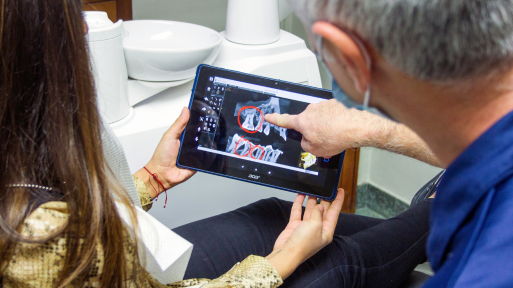 Dental X-rays are a fundamental tool in modern dentistry, offering a detailed view of your oral health that is not visible to the naked eye. These images help dentists diagnose, treat, and monitor a wide range of dental issues effectively. In this blog post, we will explore the importance of dental X-rays, how they work, and why they are essential for maintaining your overall oral health.
Dental X-rays are a fundamental tool in modern dentistry, offering a detailed view of your oral health that is not visible to the naked eye. These images help dentists diagnose, treat, and monitor a wide range of dental issues effectively. In this blog post, we will explore the importance of dental X-rays, how they work, and why they are essential for maintaining your overall oral health.
What Are Dental X-Rays?
Dental X-rays, also known as radiographs, are a type of imaging that allows dentists to see beneath the surface of your teeth and gums. Using a small amount of radiation, these images capture the internal structure of your teeth, roots, jawbones, and surrounding tissues. There are several types of dental X-rays, including:
- Bitewing X-Rays: These show the crowns of your upper and lower teeth and are useful for detecting cavities and checking the fit of dental restorations.
- Periapical X-Rays: These provide a view of the entire tooth, from the crown to the root, and are used to detect issues below the gum line, such as abscesses or cysts.
- Panoramic X-Rays: These capture a broad view of your entire mouth, including the jaws, teeth, sinuses, and temporomandibular joints, and are helpful for assessing overall oral health and planning treatments.
- Occlusal X-Rays: These show the floor of the mouth and are used to examine tooth development and placement in children.
The Benefits of Dental X-Rays
Early Detection of Dental Issues
One of the primary benefits of dental X-rays is their ability to detect dental problems at an early stage. Many dental issues, such as cavities, gum disease, and infections, may not be visible during a routine dental exam. X-rays can reveal these hidden problems before they become severe, allowing for timely and less invasive treatments.
Assessment of Tooth Development and Alignment
Dental X-rays are crucial for monitoring the development and alignment of teeth, especially in children and adolescents. They help dentists identify issues such as impacted teeth, overcrowding, and alignment problems that may require orthodontic intervention. Early detection of these issues can lead to more effective and straightforward treatments.
Evaluation of Bone Health
X-rays provide valuable information about the health of your jawbones and the bone surrounding your teeth. This is particularly important for diagnosing and managing conditions such as periodontal disease, which can lead to bone loss and tooth mobility if left untreated. X-rays also play a vital role in assessing bone density and planning dental implants.
Detection of Hidden Infections and Abscesses
Infections and abscesses can develop below the gum line or within the roots of teeth, making them difficult to detect without X-rays. These conditions can cause significant pain and lead to severe complications if not treated promptly. X-rays help dentists identify infections early and plan appropriate treatments to prevent further damage.
Planning and Monitoring Treatments
Dental X-rays are essential for planning various dental treatments, such as root canals, extractions, and implants. They provide a detailed view of the affected area, enabling dentists to perform procedures with greater precision and safety. X-rays also help monitor the progress of ongoing treatments, ensuring that they are effective and making any necessary adjustments.
Safety of Dental X-Rays
While dental X-rays do involve exposure to a small amount of radiation, advancements in technology have made them much safer. Digital X-rays, in particular, use significantly less radiation compared to traditional film X-rays. Dentists also take precautions, such as using lead aprons and thyroid collars, to minimize your exposure and ensure your safety.
It's important to understand that the benefits of dental X-rays far outweigh the risks, especially when they are used appropriately and sparingly. Your dentist will only recommend X-rays when necessary, based on your individual oral health needs and risk factors.
How Often Should You Get Dental X-Rays?
The frequency of dental X-rays depends on several factors, including your age, oral health history, and risk of dental issues. For new patients, dentists often recommend a full set of X-rays to establish a baseline for future care. After that, the need for X-rays will vary:
- Routine Check-Ups: For patients with no significant dental issues, bitewing X-rays may be recommended every one to two years.
- High-Risk Patients: Those with a history of dental problems, such as frequent cavities or gum disease, may need X-rays more often to monitor their condition.
- Children and Adolescents: Growing patients may require X-rays more frequently to assess tooth development and address any alignment issues early.
Schedule a Visit to the Dentist
Dental X-rays are an indispensable tool in maintaining optimal oral health. They provide a comprehensive view of your teeth, gums, and jawbones, enabling early detection and treatment of dental issues that might otherwise go unnoticed. By incorporating X-rays into your regular dental care routine, you can ensure that any problems are addressed promptly, leading to better outcomes and a healthier smile. Always follow your dentist's recommendations regarding X-rays to benefit from this essential diagnostic tool while minimizing any risks. Your smile and overall oral health will thank you for it. Schedule an appointment today.

